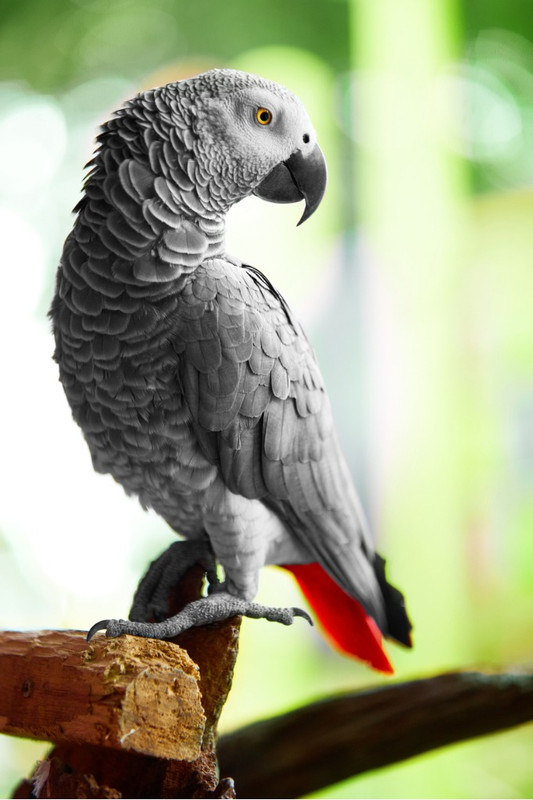African Grey Parrots
 Known for their intelligence and amazing vocabulary, African grey parrots are a popular pet psittacine. There are two species of African grey parrot. The Congo African grey is the larger of the two and is more well known. It has a completely black beak with bright red tail feathers. The Timneh African grey is the smaller of the two species and has a more pale colored upper beak and darker tail feathers. Due to their extreme intelligence and sociable nature, they require lots of attention from their family and plenty of stimulating activities throughout the day to keep their minds occupied.
Known for their intelligence and amazing vocabulary, African grey parrots are a popular pet psittacine. There are two species of African grey parrot. The Congo African grey is the larger of the two and is more well known. It has a completely black beak with bright red tail feathers. The Timneh African grey is the smaller of the two species and has a more pale colored upper beak and darker tail feathers. Due to their extreme intelligence and sociable nature, they require lots of attention from their family and plenty of stimulating activities throughout the day to keep their minds occupied.
Living with African greys requires an individual to have lots of time for one-on-one attention. When a bird is not interacting directly with its caretakers, they should have numerous toys and activities to explore in their cage. African greys can benefit from being taught how to forage for their food items. Foraging takes up much more time in a birds day and allows them to focus on meaningful behaviors. To learn more about foraging click here. In addition, toys need to be provided. African greys often like “puzzle” toys that they have to figure out. Many of these types of toys are currently available at pet stores and online stores. Homemade toys can also be used as a lower cost way of adding some stimulating objects for the bird to explore. People can use their imaginations and take old boxes, cardboard paper towel rolls, and cleaned out plastic bottles and turn them into various types of toys.
Cage set-up requires that a African greys have numerous size perches with variable width and texture. Natural wood perches like manazanita, java and dragonwood branches can be used. Cotton and sisal rope can be used as well. Pumice perches can be used to help keep nails trim but must be used cautiously. It is best to have only one pumice perch in the cage and keep it in a location where the bird will not stand on it the majority of the day. Sand paper perches should be avoided.
African grey parrots are known to occasionally suffer from having too low of blood calcium levels. Therefore, getting exposure to ultraviolet- B radiation is recommended as it is for all birds. This type of radiation allows for a bird to naturally make vitamin D3 in its body. This is then utilized to allow for calcium absorption from the diet. This calcium is then used by the body for various functions such as having a strong skeleton, having normal muscle contractions, laying eggs and having a normal nervous system. Birds can get exposure to ultraviolet-B radiation by being exposed to unfiltered sunlight. This means getting a bird outside in direct sunlight. Glass windows filter out all this important ultraviolet-B radiation. A bird should be monitored closely while outdoors however to ensure it does not over heat or fly away. If you do not have a safe way to give your bird access to unfiltered sunshine, a safe alternative is to provide a lamp that emits ultraviolet-B, such as Zoomed's Avisun 5.0. These lights should be 12-18 inches from the bird and used for around 6 hours a day.
African grey parrots require a healthy diet just like other birds. It is recommended that the majority of the diet be in the form of a pellet. Fresh vegetables, fruits and grains should make up the remainder. To learn more about general diet recommendations for psittacines click here. African greys may require a little more protein and calcium than other species of psittacines. More research needs to be done on this but ways to get a more of these in the diet include offering things like beans, quinoa, tofu, kale, apricots, almonds and walnuts. If you are switching your African grey to a pellet diet and need some help please refer to our handout on tips for diet conversion here.



